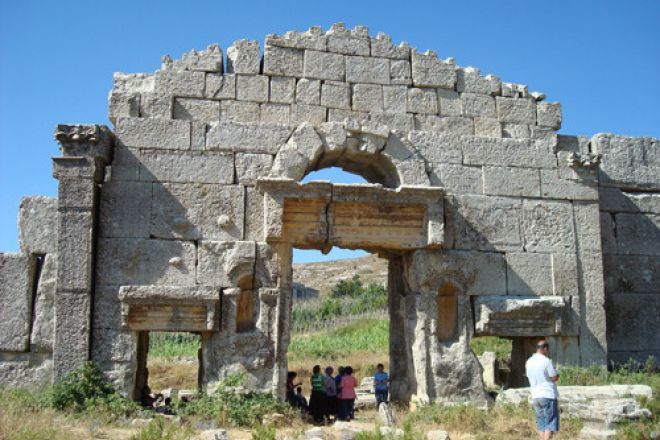Between the tips of the Mediterranean waves and the peaks of Lattakia’s mountains, between the tender olive leaves and the merciless thunders of winter, there….,on a high peak near Safita and Dreikish stands a huge edifice, challenging time and nature, it is the temple known as Solomon’s Fort.
The name of Solomon’s Fort (Hosn Suleiman in Arabic) is rather new and local. The building is far from being a fort or a citadel or any military installation, and nobody knows exactly why it was called so, since there are no documents that refer to the name. The word “fort might have been given to it due to the large stones used in constructing it or for being built in a rather difficult location in the mountains, so that people thought it was built by the genii of Wise Solomon, and the village in proximity was called by the same name “Bet Gennii. The site is located in an amphitheater of mountains that surround it from the north, east and south and is open to a valley of wall nut, vine, berry, olive, oak and plane trees. Therefore it is protected from the cold winds that come from the north and the east in winter and it receives the fresh, humid air that comes from the west in summer.
The temple was known as Bet Khikhi, originally a Canaanite temple (in the region of Arwad, 30 km from the shores of the Mediterranean) the name Bet Khikhi is a Semitic name and might belong to that era. The remains of the present edifice belong to the second or the third century AD and might had been built by the Sephari dynasty of Syria 193-229 AD as Dr. Adnan al Bunni, former director of archaeological excavations in the General Administration of Archaeology and Museums.
The temple consists of a large rectangular building 144 m long,and 90 m wide built from huge blocks, some of which are ten meters long and 2.5 m thick. Some of these stones fell down because of repeated floods and quakes. Every wall has a central gate that leads to the courtyard of the temple and while the southern gate is simple in architecture, the eastern and western gates are lavishly ornamented. The main entrance of the temple and the most elaborate one is the northern gate, a huge gate with three doors, the main one in the center from where people used to get into the court prepared for the ritual practices .While the court was open to the public the cella was exclusively used by the clerics. The cella was built on a high platform with a wide, 38 step, scale leading to it with two flat areas bearing the altars. When the temple was renovated by the wealthy people of the region, the walls were supported by half columns following the Roman style, common at that time in the Mediterranean region, while the court kept the Canaanite style.
Now Solomon’s Fort is one of the most preserved Syrian Bet Khikhi temple was under the custody of the local common people .If you cross the road Just north of the fort you can see scant remains knownas the monastery, believed to have been a separate temple adapted later on for use as a Christian convent and basilica. Solomon’s Fort can be reached via a direct bus service from Dreikish or from Safita, (every 60 or 90 minutes – 30 minutes; S&20). Once you get there you will stand in front of the greatness of the sight, astonished, unable to speak, a great monument in the lap of the charming beauty of nature. All you can do is to ask yourself who built this wonder? Very accurate designs, huge blocks of stone without any variation or differences as if struck in one mold. This is the Syrian land that had been begetting civilizations since the dawn of history. Here is Hosn Suleiman, there…., are Ugarit, Apamea, Mari and Ebla. Syria, really, is as described by Georgiou Botchellani, head of the American mission excavating in Syria: “When I am in Syria, I find myself dissolved in its history, because every particle of its soil is a letter of light in the history of humanity”.
Haifaa Mafalani

